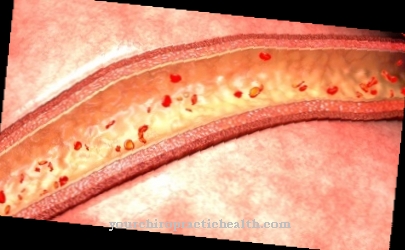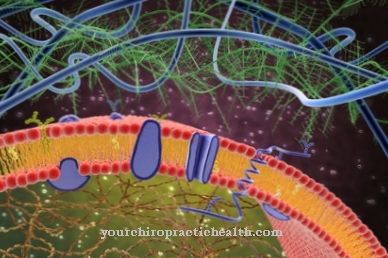Of the Ultrashort feedback mechanism is a control circuit for endocrine secretion in autocrine and paracrine glands. In this control loop, a hormone inhibits its own release without intermediate steps or other hormones. Dysregulations in the ultra-feedback mechanism can result from diseases such as Graves' disease.
What is the Ultrashort Feedback Mechanism?

Glands and gland cells produce secretions. They are either endocrine or exocrine in nature. Endocrine glands produce hormones, or hormone-like substances, that are released into the body through various modes of secretion.
In order to keep the household in balance, the secretion of gland cells in the human organism is regulated by various control circuits. One of these control loops is the so-called ultrashort feedback mechanism, which plays a role primarily for endocrine secretion. In this control loop, a hormone inhibits its own release.
In addition to the autocrine secretion modes, the control loop is also decisive for the paracrine secretion mode. Autocrine hormones inhibit or stimulate the secreting gland cell. With paracrine hormone secretion, the hormone binds to the receptors of tissues in the immediate vicinity. The regulation takes place with the ultrashort feedback mechanism without the intermediate step of another hormone. This distinguishes the control loop from other control mechanisms.
Other physiological feedback loops are the short feedback, the long feedback or the ultralong feedback.
Function & task
Control loops create a balance in physiological environments. This balance is particularly important in the endocrine system, because individual hormone secretions influence each other. The dysregulation of a single hormone can bring the entire hormonal balance out of balance and cause numerous complaints that can even have life-threatening consequences.
In addition to the hormonal balance, the control circuit of the ultrashort feedback mechanism regulates immunological processes and individual processes at synapses of excitable cells. In the hormonal area, for example, LH and FSH secretion are based on an ultrashort feedback mechanism. The autoregulatory properties during the increment (internal secretion) of the hypothalamic hormones GnRH and galanin are also due to the mechanism. A less typical ultrashort feedback is the CRH secretion control loop in the hypothalamus. Here the ultrashort loop shows itself as positive feedback and allows CRH to inhibit its own release during stress.
One of the best-known and most typical examples of the ultrashort feedback mechanism is the Brokken-Wiersinga-Prummel control circuit, which leads to an auto-inhibition of the TSH hormone. The regulation mechanism is also known as the Prummel-Wiersinga control loop. In this ultrashort feedback mechanism, pituitary TSH binds to thyrotropin receptors, which are located on the folliculostellar cells in the tissue of the anterior pituitary gland. Presumably in this way the secretion of TSH in all thyroid cells is inhibited via thyroid stimulin. This control circuit corresponds to a section of the thyrotropic control circuit and not only prevents excessive TSH secretion, but also gives the TSH level pulsatility (pulse rate).
Every ultrashort mechanism in the human body can theoretically fail or be incorrectly regulated due to disease processes and thus disrupt the hormonal balance. This means that unusual ultrashort feedback can be symptomatic in the context of various diseases. One of the most well-known examples of a condition affecting ultrashort feedback is Graves' disease.
Illnesses & ailments
Like all dysregulations in the hormonal area, Graves' disease manifests itself in a variety of complaints and affects various processes in the patient's body. The disease is an autoimmune thyroid disease that is associated with HLA-DR3 and other autoimmune diseases. The main symptom of Graves' disease is excessive antibody production on the follicle cells of the thyroid gland. These antibodies correspond to the IgG types and mimic the effects of TSH. The TSH receptors of the thyroid are stimulated so strongly and permanently.
The ultrashort feedback mechanism is no longer able to auto-regulate hormone production. The permanent stimulation of the TSH receptors leads to a chronic growth stimulus, which favors goitre. This is a pathological enlargement of the thyroid that is associated with an overactive organ. The gland cells then secrete excessive amounts of T3 and T4.With this secretion, they cause thyrotoxicosis.
Due to the external binding of the antibodies produced, endocrine orbitopathies or pretibial myxedema develop outside the thyroid gland. Because of the dysregulation in the TSH regulating system, the secretion of the TSH hormone is also suppressed by antibodies in the pituitary gland suppressing individual TSH receptors. In addition to weight loss despite increased appetite, diarrhea, hyperhidrosis, polydipsia and heat intolerance, symptoms such as tremor, decreased performance or restlessness can occur.
Since the thyroid hormone also has an effect on the cardiovascular system, cardiac arrhythmias often occur. The hair can fall out and the muscles ache.
The knowledge of the ultrashort feedback mechanism for the auto-regulation of TSH is important for the doctor in the context of Graves' disease, especially for the interpretation of the TSH level. Patients with Graves' disease have lower TSH levels because their TSH receptor autoantibodies bind to the TSH receptors and thus act directly in the pituitary gland. Through euthyroidism, they inhibit the release of TSH in the sense of an immunogenic TSH suppression. Although a significantly higher TSH level would be expected in view of the low FT4 concentrations in the patients' blood, their level remains reduced.
The treatment of hyperthyroidism turns out to be a tightrope walk in the context of Graves' disease and the TSH level can no longer be used as an exclusive assessment criterion for assessing the current metabolic situation. The attending physician must address this in order to follow an appropriate course of therapy and correctly assess the success of the therapy.






.jpg)






.jpg)

.jpg)
.jpg)











.jpg)